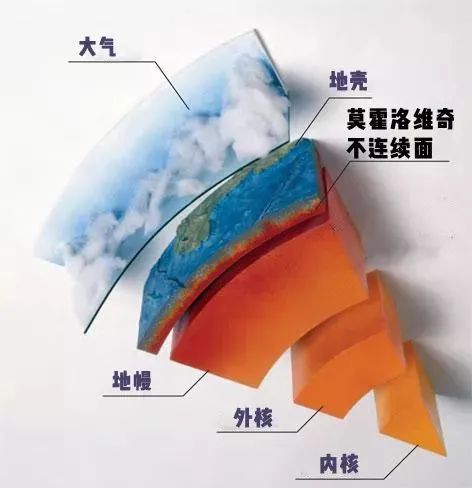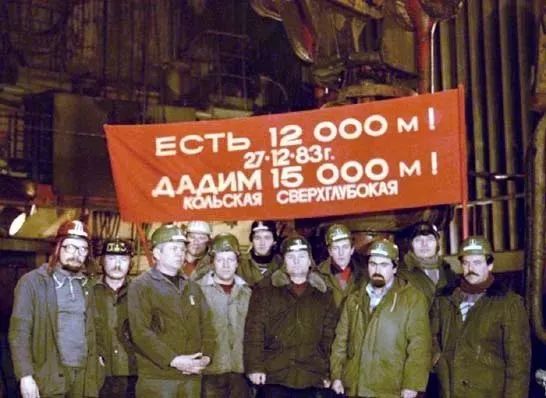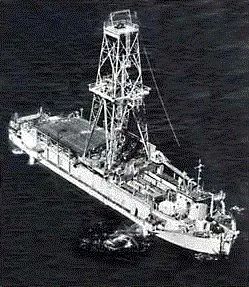Russia ‘s Kola Peninsula, in the wasteland near the Norwegian border, stands an abandoned Soviet-era scientific research station. Among the crumbling buildings, a heavy rusted manhole cover is embedded in the concrete floor. A circle of bolts was fastened firmly, as if to seal some unknown secret .  Abandoned Scientific Research Stations and Dead Wellheads | amusingplanet.com
Abandoned Scientific Research Stations and Dead Wellheads | amusingplanet.com
Under the manhole cover is the well-known Kola ultra-deep borehole (Кольская сверхглубокая скважина), which was originally just a scientific research drilling project, but became famous all over the world because of an urban legend: it is said that the Kola ultra-deep hole drilled 12,000 underground. The place where the meter is , where the excavation instruments vibrated strongly, the scientists were surprised to find that there was a cavity inside the core of the earth. They used an ultra-precision tape recorder to detect it, but heard a human-like scream, and they thought they had dug it up.” Door of hell”.
There is even an article that says, “The scientific expedition team used a geological detector to scan the entrance of the drill hole with a laser. After the ultrasonic detector detected it, the results showed that there were wails and cries and a huge explosion inside the drill hole. … Then, Russia sent Kola The drilled hole was closed again, the opening of the hole was sealed with reinforced concrete and molten steel, and the surrounding 50 kilometers were set up as a military restricted area and a no-fly zone.”  “The Well of Hell” by US Newspapers | wonkette.com
“The Well of Hell” by US Newspapers | wonkette.com
The first time I heard this story was in a drilling engineering class at the university, and then this mysterious hole aroused my strong curiosity. Now, please follow me into the ruins of the Kola Peninsula and learn about its legendary life experience.
Kola Super Deep Drilling
The legends about the gates of hell are, of course, false. In fact , the records themselves are baseless, their original source was a letter from a reader in a Finnish newspaper , only to become more and more fascinating in the process of reprinting.
Of course, aside from these strange forces, the actual Kola ultra-deep drilling is also a legendary treasure drilling.  Kola Superdeep Borehole Superstructure | Reference [3]
Kola Superdeep Borehole Superstructure | Reference [3]
The Kola ultra-deep hole is a scientific drilling project established by the Soviet Union in the Pechenga area of the Kola Peninsula in 1970. The Kola Ultra-Deep Borehole was built primarily to study the oldest rocks on our planet and understand the geological processes that took place within them .
Born during the Cold War between the United States and the Soviet Union, this drilling also carried the glorious mission of “winning glory for the country”. At that time, the two countries drilled into the deepest part of the earth, hoping that they would be the first to dig through the crust and reach Mohorovich . The discontinuity is the interface between the crust and the mantle.  The Mohorovich discontinuity diagram is as big as the Soviet Union, why did it choose to drill in the Pechenga area? In fact, this region has unique advantages. The Baltic shield, which covers the Kola Peninsula, Finland, Sweden and Norway, is one of the oldest geological regions in Europe, and Petchenga is part of this shield. Here, water, wind and glaciers have eroded the sediments that covered ancient strata hundreds of millions of years ago, allowing us to drill a well 15 kilometers deep here to see land that is usually hidden 25 kilometers or more. strata in the crust.
The Mohorovich discontinuity diagram is as big as the Soviet Union, why did it choose to drill in the Pechenga area? In fact, this region has unique advantages. The Baltic shield, which covers the Kola Peninsula, Finland, Sweden and Norway, is one of the oldest geological regions in Europe, and Petchenga is part of this shield. Here, water, wind and glaciers have eroded the sediments that covered ancient strata hundreds of millions of years ago, allowing us to drill a well 15 kilometers deep here to see land that is usually hidden 25 kilometers or more. strata in the crust.  Location of Kola Ultra-Deep Borehole | mapsofworld.com
Location of Kola Ultra-Deep Borehole | mapsofworld.com
In 1965, project leaders found a suitable drilling site. After five years of construction and preparation, the construction and installation of all drilling facilities was completed, and the construction of the industrial park and residences was completed. In 1970, a feat of engineering in human history unfolded in the Arctic Circle.  Expedition leader DM Guberman, in his standing position, built what became SG-3, the one drilled to a depth of 12,262 meters | Reference [3]
Expedition leader DM Guberman, in his standing position, built what became SG-3, the one drilled to a depth of 12,262 meters | Reference [3]
to the mantle
In 1970, to commemorate the 100th anniversary of Lenin’s birth, the Kola ultra-deep well was officially drilled. This can be said to be a vigorous scientific research project at the time. The entire research program was carried out under the direct leadership of the former Soviet Ministry of Geology, and only a handful of scientists out of thousands of researchers were able to participate in the field. All those involved in the drilling work were given an apartment in Moscow, and the monthly salary during the work period reached the annual salary of a university professor for a year. Sixteen laboratories were established at the drilling site to study the cores.  Workers are working by the drilling rig | Reference [3]
Workers are working by the drilling rig | Reference [3]
The Soviets used Uralmash-4E series drilling rigs to complete the first stage of drilling. Designed to drill 5,000 meters, and actually reached 7,263 meters. This became the deepest record achieved by the device and made the Kola ultra-deep hole the deepest hole in Europe at the time.  Uralmash-4E Rig Prospect | Reference [3]
Uralmash-4E Rig Prospect | Reference [3]
During the second stage of drilling, the technical team dismantled the old drilling rig and used the unique Uralmash-15000 unit, which finally reached 10,636 meters under extreme conditions of high temperature and pressure at the bottom of the hole. On June 6, 1979, the Kola ultra-deep well broke the previous record of 9,583 meters held by the Bertha Rogers ultra-deep well in Oklahoma, USA, and officially became the deepest ultra-deep well in the world at that time.  The Kola ultra-deep hole reached 9584 meters, becoming the deepest hole in the world at that time | Reference [3]
The Kola ultra-deep hole reached 9584 meters, becoming the deepest hole in the world at that time | Reference [3]
The drilling work has been going on in leaps and bounds. In 1983, the well reached 12,000 meters, surpassing the Mariana Trench, the deepest in the world . Drilling was halted for about a year in preparation for the International Geological Congress in Moscow in 1984, and this idle period may have laid the groundwork for subsequent accidents: in September 1984, after drilling to 12,066 meters, a A 5000m drill string broke and remained in the borehole. Subsequent drilling could only be restarted from a depth of 7,000 meters .  In 1983, the Kola ultra-deep hole reached 12,000 meters | Reference [3]
In 1983, the Kola ultra-deep hole reached 12,000 meters | Reference [3]
In 1989, the Kola ultra-deep borehole reached its maximum depth for the first time – 12,262 meters. Crews are optimistic that the drilling depth will reach 13,500 meters in 1990 and 15,000 meters in 1993.
But they soon found that the temperature of the crust at this depth was 100°C higher than expected, reaching 180°C . The equipment was damaged so badly at this temperature that it was no longer feasible to drill deeper, so the drilling work began in 1992. The official reason to stop, stop drilling is lack of funding . From 12,000 meters to 12,262 meters, the short 262 meters took a full decade to make progress.  Core samples taken from the Kola ultradeep well in the 1980s | amusingplanet.com
Core samples taken from the Kola ultradeep well in the 1980s | amusingplanet.com
Although drilling was stopped in 1992, data and data research on the Kola ultra-deep well continued for several years after that, until funding ran out in 2006. In 2008, the site was abandoned, the Kola ultra-deep borehole was firmly sealed, and a legend finally came to an end.  Geologists observing cores taken from boreholes | Reference [3]
Geologists observing cores taken from boreholes | Reference [3]
Has the Kola superdeep hole been successful?
Since the Kola ultra-deep hole has been drilled so deep, has it completed the glorious mission that people gave it and successfully drilled to the Moho surface? The answer is very regrettable, not only not, but also more than a little short , it only reaches 1/3 of the Baltic shield. Let us illustrate with a picture.  Diagram of the inner circle of the Earth | Wikipedia
Diagram of the inner circle of the Earth | Wikipedia
Generally speaking, the thickness of the crust is in the range of 5-70 kilometers, the thickness of the oceanic crust is smaller, about 8 kilometers, and the thickness of the continental crust is 20-70 kilometers. So even at the thinnest continental crust, the Kola ultra-deep hole is only halfway through, let alone the thicker ones. According to the average radius of the earth of 6371 kilometers, the Kola ultra-deep hole has only drilled 0.2% of the position , which is too insignificant.
Seeing this, you may also ask this question: since the continental crust is so thick and the oceanic crust is so thin, why not drill ultra-deep holes in the oceanic crust?
Drilling ultra-deep holes in the oceanic crust
How could researchers not think of such a simple question? In fact, before the Kola ultra-deep drilling project was launched, the United States had already carried out the “Moho Project” at sea, also to drill to the Moho surface. The Moho plan was originally intended to be carried out in three stages. However, due to a series of problems such as technology, management and funding, the plan was only carried out in the first stage and died.  Drillship CUSS I for Phase 1 of Project Moho | Wikipedia.org
Drillship CUSS I for Phase 1 of Project Moho | Wikipedia.org
In the end, the plan achieved only 183 meters below the seabed , but it cost 57 million US dollars , which was undoubtedly a huge sum of money in 1966. In the words of a geologist at the time, the project was equivalent to standing on a high-rise building and holding a long, thin dry noodle and drilling a hole down the asphalt road . From this, we can also imagine how much human, material and financial resources it took for the Kola ultra-deep drilling to reach 12,262 meters.
What have scientists discovered
The diameter of the Kola ultra-deep hole is only about 20 centimeters, but it has helped us to peek into the colorful underground world, and scientists have even observed life activities 2 billion years ago. They found tiny plankton fossils 6 kilometers below the surface, perfectly preserved in the environment of high temperature and high pressure underground.  1987 Soviet stamp commemorating the Kola superdeep borehole | wikipedia
1987 Soviet stamp commemorating the Kola superdeep borehole | wikipedia
Deep inside the well, scientists also accidentally discovered traces of water. They speculate that it is water directly generated by hydrogen and oxygen in minerals deep in the crust, which cannot reach the surface due to a layer of impermeable rock.
According to the official website, in the stratum from 9 to 12 kilometers, the gold content in the core has reached a grade of 4 g/ton, which has met the commercial mining requirements . Although the exploration process of the Kola ultra-deep well is completely opposite to the direction of the space race, the rocks obtained by scientists from the Kola ultra-deep well 3 kilometers away have the same composition as the lunar soil collected by the Soviet lunar rover.  Core at 12,260 m underground, obtained from the SG-3 borehole | Reference [3]
Core at 12,260 m underground, obtained from the SG-3 borehole | Reference [3]
In fact, to this day, the depth record of the Kola ultra-deep hole has been broken by some “rising stars”. In 2008, Qatar’s Ashosin well reached 12,289 meters; in 2011, Russia’s Odoptu OP-11 well on Sakhalin reached 12,345 meters; in 2012, ExxonMobil’s Z-44 Chayvo well reached 12376 meters. However, these oil wells are only better than the overall length, and they still have a certain horizontal displacement. Calculated by the actual vertical depth , the Kola ultra-deep hole SG-3 is still the deepest man-made object in the world, and it is also the world ‘s deepest man -made object. The deepest wells are drilled purely for scientific purposes .
references
[1 ] https://ift.tt/iOSLscy
[ 2] https://ift.tt/fcpP3wo
[3] https://ift.tt/VHD94NL
[4] https://ift.tt/EGj3c7x
[5] Andrei, Mihai (21 August 2018). “What are the layers of the Earth?”. ZME Science. Retrieved 28 June 2019. [6 ] https://ift.tt/cws0Huy
[7] https://ift.tt/3idqWb9
[8] Alan Bellows (5 March 2007). “The Deepest Hole”. Damn Interesting. Retrieved 27 December 2014.
[9] GJ MacDonald (1988). “Major Questions About Deep Continental Structures”. In A. Bodén and KG Eriksson (ed.). Deep drilling in crystalline bedrock, v. 1. Berlin: Springer-Verlag. pp. 28– 48. ISBN 978-3-540-18995-4.
[10] https://ift.tt/IHS5kNn
Author: The Other Shore The Wind Blows Editor: Da Linzhao 
This article is from guokr and may not be reproduced without authorization. If necessary, please contact [email protected] 
This article is reproduced from: http://www.guokr.com/article/462720/
This site is for inclusion only, and the copyright belongs to the original author.